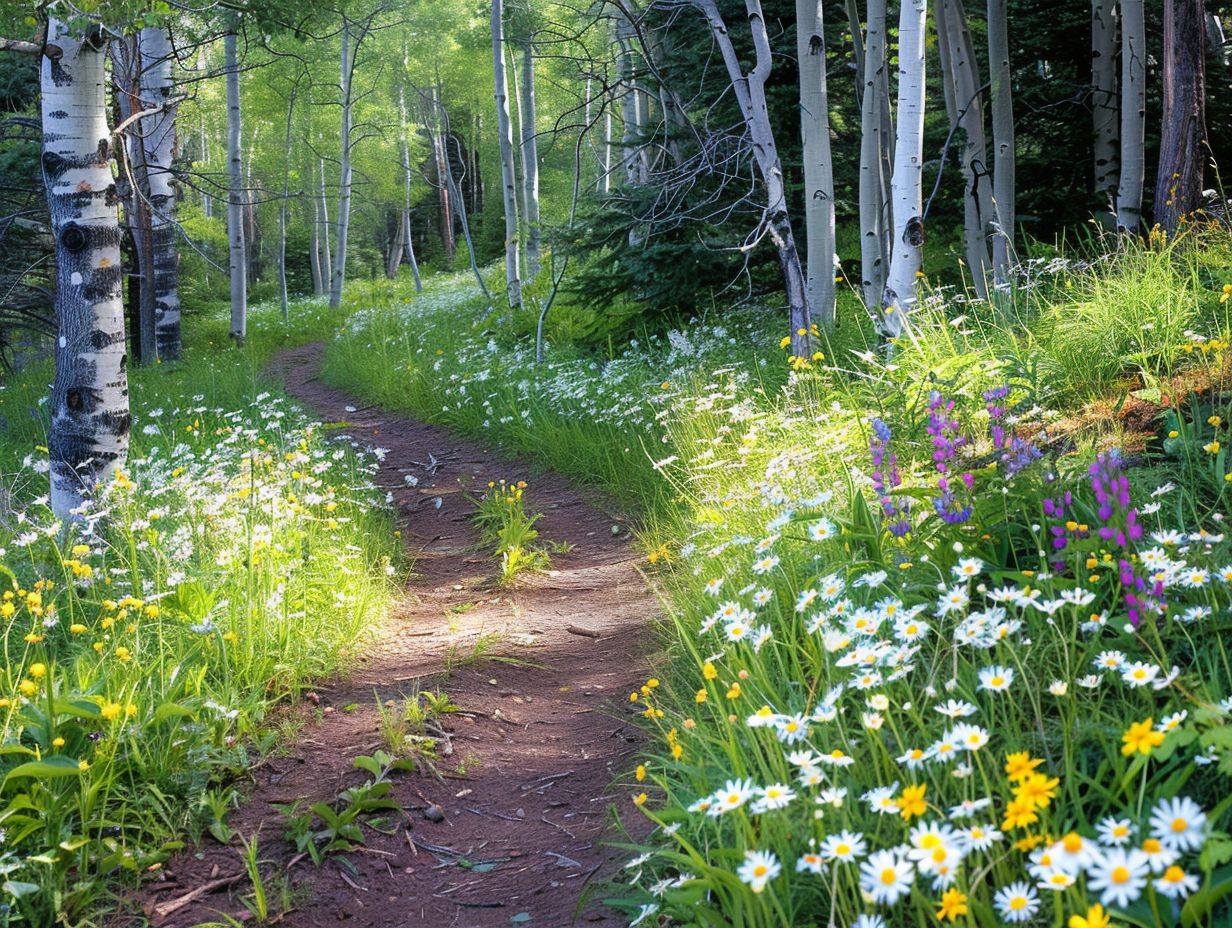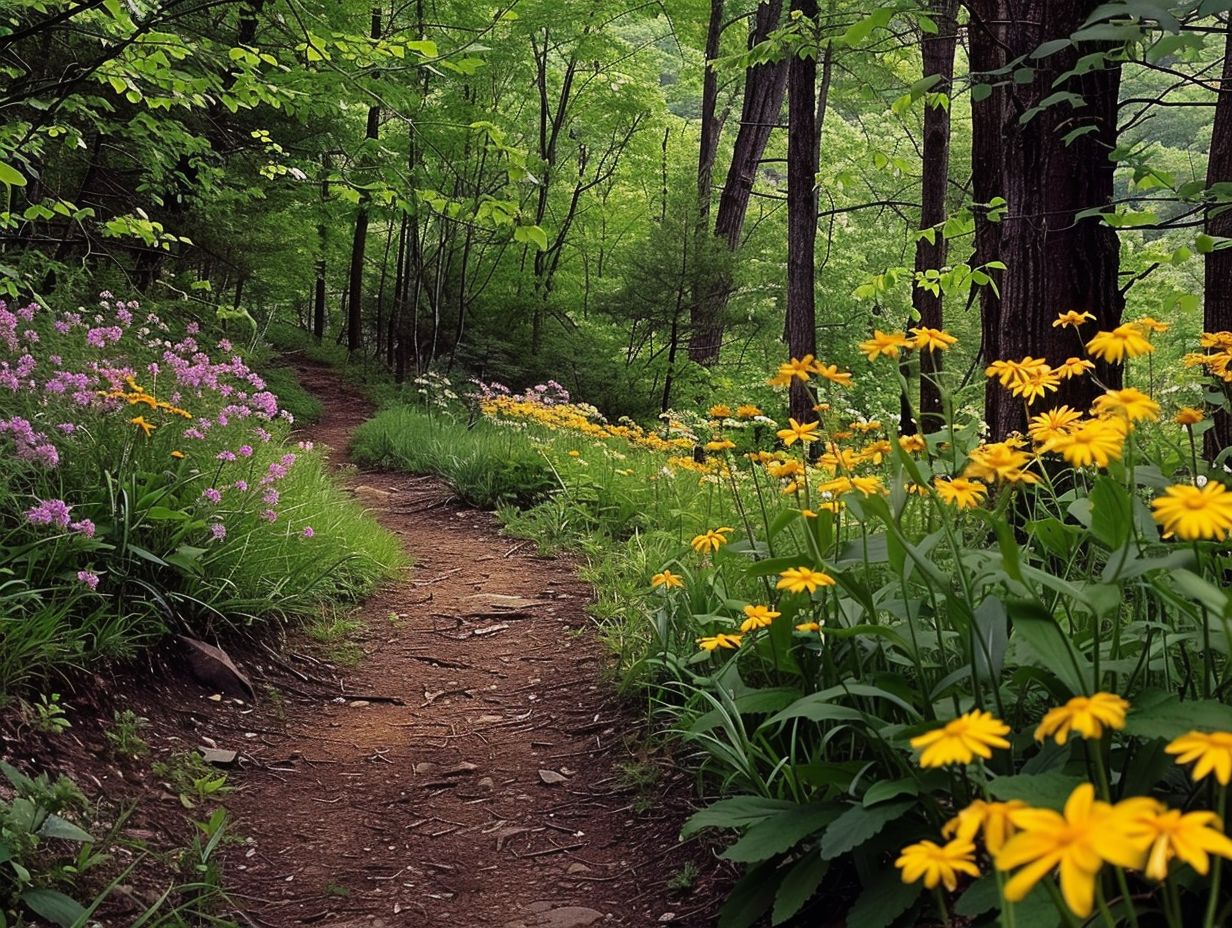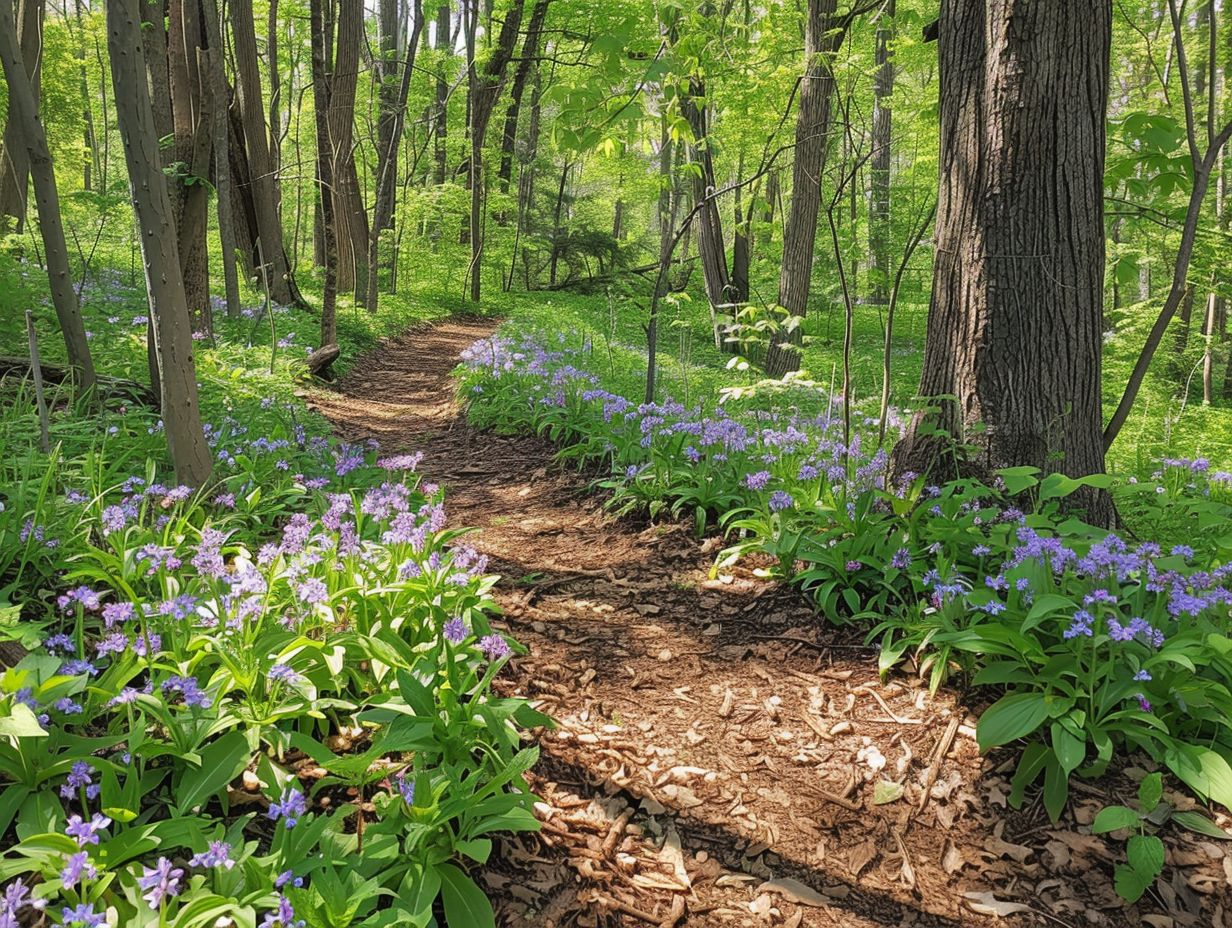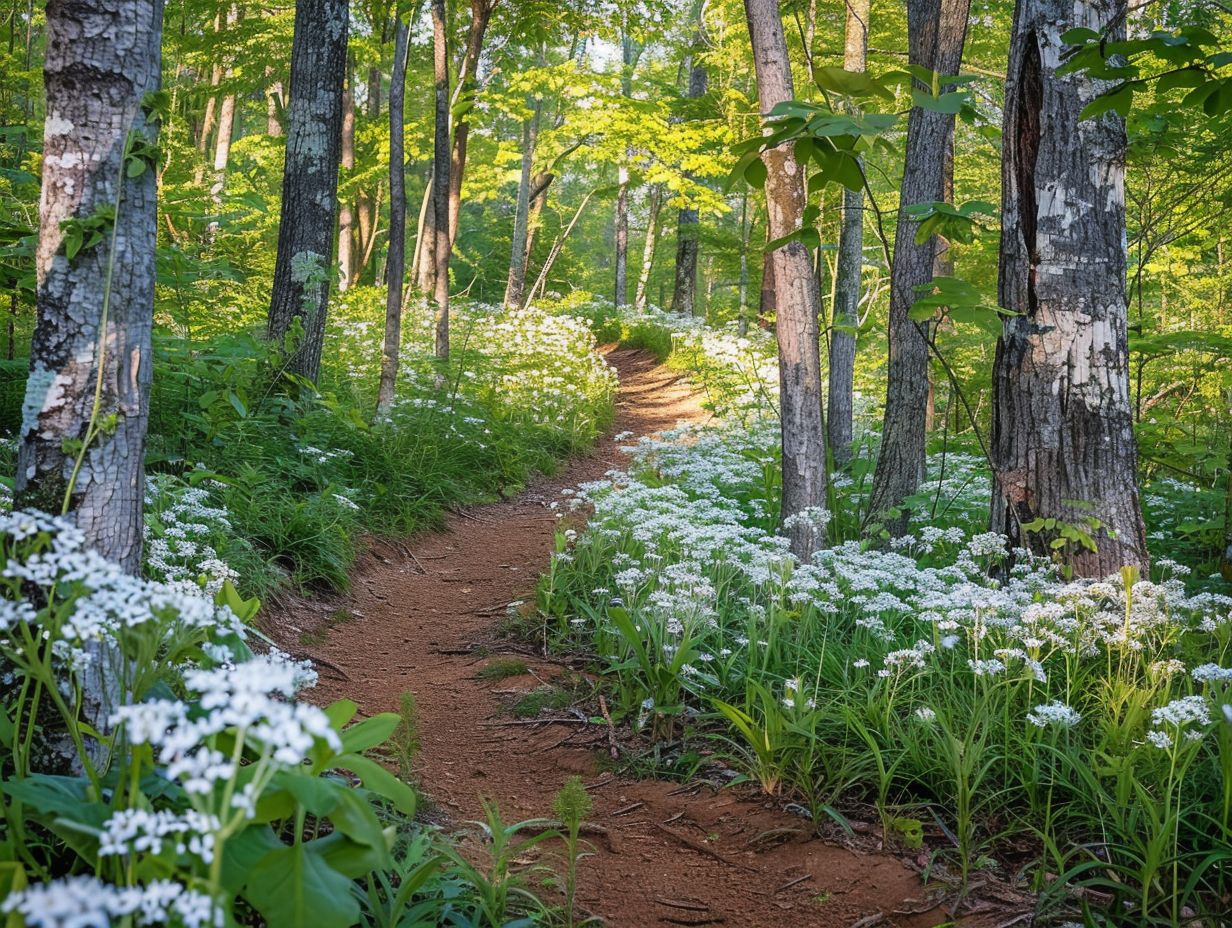The Pacific Northwest, Rocky Mountains, and the Southwest each offer breathtaking showcases of wildflowers that can enrich your camping adventures. In this guide, we will discuss the optimal times to witness wildflowers in these regions, top campsites for enjoying wildflower walks, the varieties of wildflowers you may encounter, and recommendations for a successful outing.
Whether you are an experienced hiker or simply seeking to enhance the beauty of your camping excursion, embarking on wildflower walks is a highly recommended activity.
Key Takeaways:

- Plan your wildflower walks during the peak blooming seasons in each region for the best viewing experience.
- Some popular campsites in the Pacific Northwest, Rocky Mountains, and Southwest regions for wildflower walks include Mount Rainier National Park, Yellowstone National Park, and Grand Canyon National Park.
- From lupines to columbines, the Pacific Northwest, Rocky Mountains, and Southwest regions offer a diverse array of wildflowers for nature lovers to discover.
1. Wildflower Walks Near Campsites in the Pacific Northwest
Exploring the Pacific Northwest presents you with a remarkable opportunity to observe the beauty of wildflowers amidst the breathtaking landscapes of Oregon. From the vibrant blooms in the Columbia River Gorge to the tranquil meadows surrounding Marys Peak, the region calls out to both hikers and nature enthusiasts.
The varied trails in the Pacific Northwest offer an ideal setting for unforgettable wildflower excursions, providing options that range from relaxing walks through colourful meadows to challenging hikes up mountain slopes adorned with blossoms.
Along these trails, you will encounter a variety of wildflower species such as lupine, trillium, and paintbrush, forming a vibrant tapestry of colours that heralds the arrival of spring.
With a range of campsite choices available nearby, including rustic sites tucked away in the forest or picturesque locations with views of cascading waterfalls, exploring the Pacific Northwest during the spring bloom transforms into an immersive nature adventure.
2. Wildflower Walks Near Campsites in the Rocky Mountains
Embark on a journey through the Rocky Mountains and immerse yourself in the enchanting world of wildflowers that adorn the rugged terrain. From colourful blooms on mountain peaks to tranquil meadows perfect for a campfire evening, the Rockies offer a picturesque setting for nature lovers.
As you venture along popular trails like the Continental Divide Trail or explore the heights of peaks such as Mount Elbert and Longs Peak, a kaleidoscope of wildflower species greets your senses.
Picturesque camping spots like Moraine Park in Rocky Mountain National Park or Little Molas Lake Campground in the San Juan Mountains provide a front-row seat to nature’s floral masterpiece.
The carpet of vibrant petals and fragrant blossoms against the backdrop of towering Rockies creates a scene that truly encapsulates the essence of natural beauty.
3. Wildflower Walks Near Campsites in the Southwest
Explore the vibrant tapestry of wildflowers that grace the arid landscapes of the Southwest, transforming deserts into stunning floral wonderlands. From the blooming trails of Arizona to the colourful displays in California, the Southwest region offers you a unique wildflower experience amidst its rugged terrain.
Embark on popular trails like the Superstition Mountains in Arizona or the Antelope Valley Poppy Reserve in California, where you can witness nature’s artistic beauty on full display. Camping sites such as Joshua Tree National Park provide an immersive experience, allowing you to wake up to a sea of blossoms right at your doorstep.
The Southwest’s spring bloom is a spectacle you cannot afford to miss, attracting nature enthusiasts and photographers alike who seek to capture the transient beauty of wildflowers set against the desert backdrop.
What Are the Best Times to See Wildflowers in the Pacific Northwest?
The best times to see wildflowers in the Pacific Northwest, particularly in Oregon, are during the spring months when the landscape comes alive with a riot of colours and blooms. In April and May, areas like the Columbia River Gorge and Mount Hood in Oregon burst with lupin, paintbrush, and wild roses.
Moving into June, the Cascade Mountains offer stunning displays of avalanche lilies and bear grass. The Olympic Peninsula in Washington is another hotspot, showcasing vast fields of camas and shooting stars during the same period.
To catch the wildflowers at their peak, one should plan a visit during these months for an awe-inspiring floral spectacle across the Pacific Northwest.
What Are Some Popular Campsites in the Pacific Northwest for Wildflower Walks?
Popular campsites in the Pacific Northwest, such as those near the Columbia River Gorge and Marys Peak in Oregon, provide excellent bases for embarking on wildflower walks amidst breathtaking natural scenery.
These campsites not only offer stunning views but also boast convenient amenities like clean restrooms, picnic areas, and drinking water facilities, ensuring a comfortable stay in the wilderness. Located just a short distance away from picturesque trails, these campsites serve as perfect starting points for wildflower excursions.
Visitors can easily access the abundant wildflower fields and diverse plant species, immersing themselves in the rich biodiversity of the region. Whether you’re a seasoned hiker or a nature enthusiast looking to explore the beauty of the Pacific Northwest, these campsites are ideal for a memorable outdoor experience.
What Types of Wildflowers Can Be Found in the Pacific Northwest?

In the Pacific Northwest, you will encounter a diverse range of wildflowers that enhance the beauty of the landscapes near renowned locations such as the Columbia River Gorge and Marys Peak.
Lupins, featuring vibrant purple, blue, and pink blooms, are commonly sighted along hiking trails and meadows in the area.
Aquilegias, prized for their delicate bell-shaped flowers in red, yellow, and white tones, flourish in shaded areas near streams and forests. Paintbrushes, showcasing striking red, orange, or pink bristles atop slender stems, provide a burst of colour to rocky slopes and alpine meadows.
Each of these wildflower species contributes to the magnificent array of colours that adorn the natural scenery of the Pacific Northwest.
What Are Some Tips for a Successful Wildflower Walk in the Pacific Northwest?
To maximise the enjoyment of your wildflower walk in the Pacific Northwest, particularly in areas like Marys Peak in Oregon, it is advisable to begin early, pack essential items such as water and snacks, adhere to designated trails, and show respect for the fragile ecosystems that sustain these floral marvels.
Whilst on your walk, it is important to walk lightly to avoid damaging the exquisite wildflowers that you have come to appreciate. Be attentive to wildlife and demonstrate respect for their natural habitat by observing from a distance.
Additionally, it is recommended to inform someone of your hiking itinerary and anticipated return time as a safety measure. Carry a map or utilise a GPS device to stay on the right path and avoid getting lost in the vast wilderness. By following these guidelines, you can fully relish your wildflower excursion while minimising any adverse impact on the environment.
How Can Wildflower Walks Enhance the Camping Experience?
Engaging in wildflower walks near campsites can significantly enhance your camping experience by offering you a closer connection to nature, serene views of blooming meadows, and the opportunity to relax amidst a colourful tapestry of flowers under the open sky.
These walks allow you to immerse yourself in the beauty of the wildflowers, providing you with a sense of tranquillity and a chance to practise mindfulness. Observing the delicate petals and vibrant colours can be a grounding experience, fostering a deeper appreciation for the environment.
It adds an extra dimension to your camping trip, creating moments of peace and wonder as you stroll through fields of blossoming wildflowers, surrounded by the symphony of nature.
What Are the Best Times to See Wildflowers in the Rocky Mountains?
The best times for witnessing the vibrant display of wildflowers in the Rocky Mountains, spanning across Colorado and Montana, are typically during the late spring and early summer when the alpine meadows burst alive with a kaleidoscope of colours.
During July and August, the mountain slopes are bedecked with a plethora of blooms, ranging from delicate columbines to fiery Indian paintbrushes, creating a picturesque spectacle that enchants visitors.
Those looking to experience the peak blooming seasons should schedule their visits around these months to fully engage with the stunning floral diversity. Each trail and valley conceals its own unique array of flowers, providing a visual treat and a deep connection to the natural beauty thriving in these rugged landscapes.
What Are Some Popular Campsites in the Rocky Mountains for Wildflower Walks?
When visiting popular campsites nestled in the heart of the Rocky Mountains, you will find an ideal base for exploring diverse landscapes as a wildflower enthusiast. These campsites offer majestic peaks, blooming trails, and scenic spots perfect for enjoying a campfire evening under the starlit sky.
The well-maintained trails weaving through valleys adorned with vibrant wildflowers provide an immersive experience for nature lovers. The proximity to crystal-clear streams and dense forests adds to the allure, offering ample opportunities for wildlife sightings and birdwatching.
Campers can wake up to the soothing sounds of nature and embark on unforgettable hikes to capture breathtaking sunrise views from panoramic lookout points. The camp facilities cater to hikers with amenities such as designated cooking areas, clean restrooms, and well-marked trails for varying skill levels.
What Types of Wildflowers Can Be Found in the Rocky Mountains?
The Rocky Mountains offer a diverse collection of wildflowers, ranging from alpine blossoms gracing the mountain peaks to delicate flowers covering the valleys, presenting a vibrant display of colours and species unique to this renowned mountain range.
These wildflowers have developed remarkable adaptations to the varying altitudes, climates, and habitats present in the Rocky Mountain ecosystem.
At higher elevations, one can encounter robust species like alpine forget-me-nots and alpine sunflowers, which have evolved mechanisms to flourish in the challenging conditions of high altitudes with thin air and cold temperatures.
Conversely, lower elevations host a different variety of flowers such as columbines and lupines, which bloom abundantly in the more temperate climates and diverse soils found in the valleys.
Each species contributes its distinct beauty and significance to the diverse biodiversity of the Rockies.
What Are Some Tips for a Successful Wildflower Walk in the Rocky Mountains?

When embarking on a wildflower walk in the Rocky Mountains of Colorado and Montana, it is essential to plan your hike meticulously.
Take into account factors such as elevation, weather conditions, trail difficulty, and possible wildlife encounters to ensure a safe and enjoyable experience while surrounded by the breathtaking beauty of wildflowers.
Begin by checking the weather forecast and packing accordingly. Equip yourself with appropriate layers, a first aid kit, an ample water supply, and high-energy snacks. Ahead of hitting the trail, always communicate your plans and estimated return time with a trusted individual.
When choosing a trail, evaluate your skill level, physical fitness, and the hike’s length. Stay on designated paths to prevent any harm to delicate wildflowers and wildlife habitats. In bear country, carry bear spray and remain vigilant for other wildlife encounters.
Lastly, practice Leave No Trace principles by carrying out all rubbish and treating the natural environment with the utmost respect.
How Can Wildflower Walks Enhance the Camping Experience in the Rocky Mountains?
Immerse yourself in wildflower walks near campsites in the Rocky Mountains of Colorado and Montana to enhance your camping experience with a touch of natural beauty. You will be treated to panoramic views of blooming meadows, fragrant blooms, and the serene ambiance of mountain peaks.
These enchanting walks among the wildflowers will take you on a sensory journey where the vibrant colours and delicate petals will captivate your sight. The sweet scents of the blooms will waft through the crisp mountain air, encouraging you to take deep breaths and cherish the moment.
The diverse wildflower species carpeting the landscapes will offer an aesthetic appeal, transforming the surroundings into a painter’s masterpiece. This enhancement will elevate the serene atmosphere and provide a peaceful backdrop for your wilderness retreat.
What Are the Best Times to See Wildflowers in the Southwest?
In the Southwest region, which includes Arizona and California, you can witness the stunning display of wildflowers during the spring months. This natural spectacle is particularly vibrant from March to May, as the typically arid desert landscapes burst into a riot of colours with blooming flowers, creating a captivating sight for visitors.
During this enchanting period, the once barren deserts transform into vibrant carpets of flowers, each species showcasing its unique colours and shapes. From the iconic poppies in California to the magnificent saguaro cactus blooms in Arizona, the wildflowers present a mesmerising illustration of nature’s resilience and adaptability.
The blooming patterns vary across different elevations, offering a diverse range of species from the low-lying valleys to the lofty mountain peaks. This diversity provides enthusiasts with a rich tapestry to explore and appreciate throughout the spring season.
What Are Some Popular Campsites in the Southwest for Wildflower Walks?
Popular campsites in the Southwest, nestled amidst the blooming deserts of Arizona and California, serve as ideal gateways for nature lovers seeking wildflower walks, offering a blend of rugged trails, desert blooms, and starlit camping experiences.
Enthusiastic hikers often flock to these renowned campsites, captivated by the allure of vibrant wildflowers carpeting the desert landscapes. The opportunity to witness nature’s kaleidoscope of colours set against the backdrop of arid terrain draws you and other visitors from far and wide.
As the sun sets, the campgrounds transform into peaceful havens under the starlit sky, providing a serene ambience for you and fellow travellers to unwind after a day of exploring the unique flora that thrives in this arid region.
What Types of Wildflowers Can Be Found in the Southwest?
The Southwest region, encompassing Arizona and California, offers a diverse selection of wildflowers like poppies, lupins, and desert marigolds. Each of these flowers adds vibrant hues and intricate beauty to the arid landscapes, creating a captivating experience for nature enthusiasts.
These resilient plants have developed remarkable adaptations to thrive in the harsh desert conditions. Strategies such as deep root systems for water access, waxy surfaces to minimise water loss, and coordinated blooming schedules with seasonal rainfall patterns are just some of the ways these wildflowers have evolved.
The seasonal blooming patterns not only enhance the desert landscape with splashes of color but also play a vital role in pollination and serving as food sources for indigenous wildlife. This highlights the essential role that wildflowers play in the intricate desert ecosystem.
What Are Some Tips for a Successful Wildflower Walk in the Southwest?
When embarking on a wildflower walk in the Southwest, particularly in the arid deserts of Arizona and California, it is essential to engage in careful planning to ensure a safe and fulfilling experience.
You should always remember to carry an adequate supply of water, sunscreen, durable footwear, and develop a sharp eye for identifying the delicate blooms that thrive in these challenging environments.
Ahead of embarking on your excursion, it is advisable to check the weather forecast as desert conditions can change swiftly. Additionally, it is wise to inform a trusted individual about your hiking plans and anticipated return time for safety purposes.
While exploring the trails, you should be attentive to the wildlife, including snakes and other desert residents. It is recommended to bring along a map or GPS device to prevent becoming disoriented in the expansive desert terrain.
By demonstrating respect for the natural environment, such as remaining on designated paths and refraining from picking flowers, you contribute to the preservation of the fragile ecosystem, ensuring that future generations can also appreciate its beauty.
How Can Wildflower Walks Enhance the Camping Experience in the Southwest?

Incorporating wildflower walks into your camping experience in the Southwest can enhance your journey with the captivating beauty of desert blooms, expansive vistas of rugged landscapes, and the peacefulness of starlit nights among the floral tapestry of Arizona and California.
These wildflower walks not only provide a visual spectacle with their vivid colours and delicate petals but also immerse campers in a multi-sensory experience.
The delightful aroma of blossoms, the gentle sensation of petals under your feet, and the soft rustling of wildflowers in the breeze add layers of richness to your camping adventure.
As you wander through meadows and valleys, the cadence of your steps blends with the natural symphony of buzzing bees and chirping birds, creating a tranquil soundtrack that revitalises your soul.
Frequently Asked Questions
Where can I find information about wildflower walks near campsites?
There are several resources you can use to find information about wildflower walks near campsites. You can check with the campground or park office for any organized walks or events. You can also search online for local hiking groups or organizations that may offer guided wildflower walks. Additionally, guidebooks and maps for the area may have information on nearby wildflower trails.
What is the best time of year to go on a wildflower walk near a campsite?
The best time to go on a wildflower walk near a campsite will depend on the specific location and climate. In general, wildflower season tends to peak in the spring and early summer months. However, some areas may have wildflowers blooming throughout the year. It is always a good idea to check with local resources or park rangers for the most up-to-date information.
Are there any safety precautions I should take when going on a wildflower walk near a campsite?
Yes, it is important to take some safety precautions when going on a wildflower walk near a campsite. Be sure to wear appropriate footwear and clothing, as some trails may be rugged or have potential hazards. It is also a good idea to bring plenty of water and snacks, as well as a map or guide to the area. Additionally, be cautious of any wildlife or insects that may be present, and always stay on designated trails.
Can I bring my dog on a wildflower walk near a campsite?
This will depend on the specific rules and regulations of the campground or park where the wildflower walk is located. Some areas may allow dogs on designated trails, while others may not allow pets at all. It is important to check with the park office or do research beforehand to ensure that dogs are allowed and what specific rules must be followed.
Do I need any special equipment to go on a wildflower walk near a campsite?
Generally, no special equipment is needed to go on a wildflower walk near a campsite. However, it is always a good idea to bring a map or guidebook, as well as appropriate footwear and clothing. Some people also like to bring a camera or binoculars to get a closer look at the flowers and wildlife. Depending on the length of the walk, it may also be wise to pack snacks and water.
Are there any guided wildflower walks available near campsites?
Yes, there may be guided wildflower walks available near campsites. It is best to check with the campground or park office, as well as local hiking groups or organizations, for any scheduled walks or events. If no guided walks are available, you can always do a self-guided walk using maps or guidebooks.



